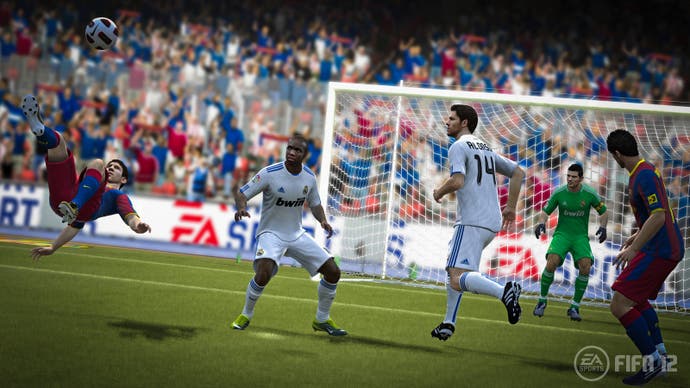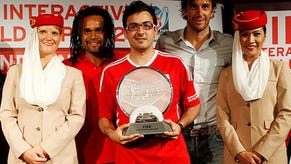FIFA 12
Making an impact.
"If someone's running through an animation cycle and something happens to them, if it's not real-time physics you can't do anything about it – you've got to complete that or branch out. If you branched out, especially in football, the amount of animations we'd have to do would be very problematic, so being able to have a 'maths' solution to it is brilliant."
Its influence runs deep in FIFA 12, not least of all in the True Injuries system. Now, by way of the number crunching that accompanies the bone-crunching tackles, the strength of the tackle and its point of impact are assessed. If a player's hit hard enough and fast enough at the wrong point, an injury will result, its severity dependent on the violence of the challenge or fall.
Over the course of a Career Mode it'll have some intriguing ramifications. There'll be the option to bring a stricken player back before they've fully recovered (and they'll likely protest your decision while the commentary team will acknowledge the situation), and doing so risks inflaming the injury.

After an hour's play, the Impact Engine certainly makes its presence felt, lending a believable physicality to the action, but its real worth will surely be seen in the long run. The bespoke nature of its animations should ensure that come the arrival of FIFA 13, this game will still be capable of throwing up surprises and novel situations.
And in those first few minutes with FIFA 12 it's not even the most striking of the new features. That honour goes to the new Tactical Defending, and more specifically the decision to fundamentally change the way the game is played when guarding the goal.
The light tackle that would constantly pressurise the opposition and move in to take the ball from the feet now simply jockeys them, keeping the defender at a player-prescribed distance from their prey, and it takes another press of the square button to go in for the kill.
It places more emphasis on timing, and does away with the button-spamming that's powered defending in FIFA's past. Lunge forward at the wrong time and it's likely to leave you stranded and create a sizable hole in the defence. Time it perfectly and it's likely the Impact Engine will kick in, with both players colliding with authentic weight.
The last of the "trinity of innovations" is precision dribbling, with a third degree of pace added to the jog and sprint of previous efforts. Intricate and close footwork is now at hand to help slow the pace of a game, with small, light touches allowing the player to shield the ball and hold up play.
Together with the emphasis placed on smart defending it leads to more open matches, and there's been a significant shift in balance towards attacking play. One unexpected and very welcome offshoot of the reworked defending and dribbling is how they both work in tandem to open up the field.
Whereas FIFA 11 would often find itself bogged down directly outside the penalty area, forcing play down the flanks, there are now tools at the attacking team's disposal to take a more direct route, holding up play and waiting for support in the right places. It helps to create a slower, more deliberate pace, and it's now the kind of game that seems just as happy supporting the imagination and flair that typifies Barcelona as it does the defend and counter of Arsenal.
It's a more inclusive game of football, and it seems to have struck a finer balance between attack and defence alongside promising a deeper, richer game. To call it revolutionary would be a push, but it can comfortably claim to be the boldest evolution the series has seen for some time.










.png?width=291&height=164&fit=crop&quality=80&format=jpg&auto=webp)



